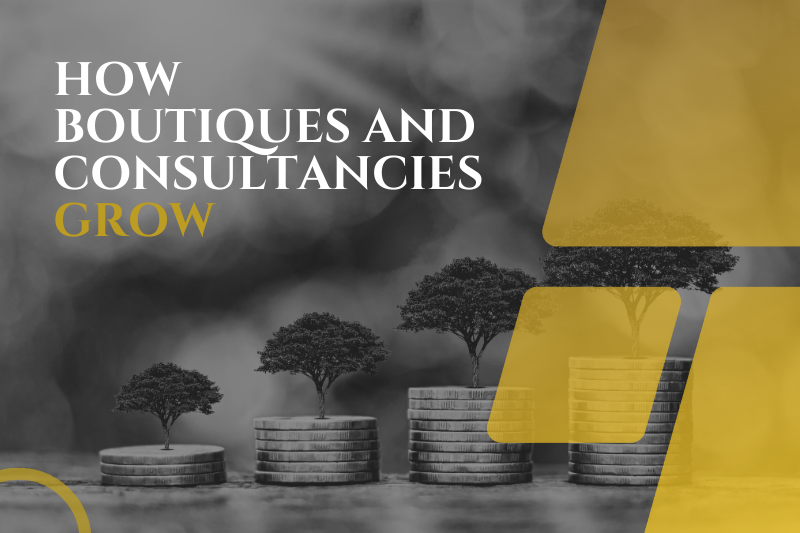In management theory, professional service firms are said to grow through a series of S-shaped stages from their founding through to billion-dollar multi-nationals. The S-shapes (Figure 3) are theorised because each stage of growth prompts new challenges which impact growth, causing the leaders to invest time and resources into structural (for example, governance, organizational, financial) solutions.[1] These in turn lead to a period of accelerated growth, which once again stalls when new problems are encountered.[2]
In practice, things are often different. Two thirds of the founders I interviewed said they did not notice a plateauing of revenues due to reasons other than bad luck (for example, losing a large client early on), losing key clients, or recessions.

This isn’t to say that they theory wasn’t right when it was invented. I found that that successful founders tended to anticipate inflection points (either through good advice or having experienced something similar before) and take premeditated action to avoid issues. In addition, Professional Service Firm automation software has reduced the bureaucracy needed for growth.
As founders can typically pay for this software by ‘seat’, the investment is gradual rather than focused on any specific growth point. Finally, it is also the case that many small firms that might have experienced a plateau ended up selling before they got to that point. Several founders explicitly told me that they did not like dealing with detailed systems, hierarchies or bureaucracy, and therefore sold before the firms ever required these kinds of investments.
The inflection point that was evident in many firms was less concerned with revenue and more to do with productivity. In the start-up phase, founders are doing everything and have no need for anything but the most basic planning systems. They are usually happy to burn the midnight oil in order to get clients that are happy to generate testimonials and referrals, and growth based on this, and their own personal connections, is often exponential. The next phase, the growth phase, is often when founders are pulled in different directions.
One of the founders I coach told me:
We’re trying to generate sales for growth, but also know that we need to build the systems to support this….We’re trying to get our new hires up to speed, but also trying to deliver. There just isn’t enough time in the day.
Sadly, there are no easy answers to this, which is why the growth phase is the hardest phase to complete successfully. In addition, in the first two phases, many firms are still working out what their core services really should be. The final stage, when the key services are in place and there are some formal systems to delegate and manage work is the scale phase, and it is here that things get a little easier for founders.

If they have built the right engine it is generally a matter of a steady hand on the wheel, sufficient fuel, and an occasional service.You can see why I get annoyed with all the internet advice on ‘scaling’ a firm! Unless you are a solo consultant or coach with primarily digital services, there is a lot of pain involved before you can get to the scaling phase!
This said, even when profits are not hit, there is often still a clear point where many CEOs report a fundamental plateau or change in the firm. This typically happens when the firm has grown to around 25-35 staff. After this point, things get a little complicated, and the informal communication and management systems that worked in the beginning begin to fall apart:
Angrez Saran, who sold 8Works to Oliver Wyman told me:
‘we got to 20 people when sharing the administrative work across your leadership team of three or four people was really hard. We were being pulled into do quite tactical things, which just didn’t make sense. So we made a conscious decision to actually outsource as much of it as possible and then bring in support. We enhanced our operations capability by bringing on an additional person’.
Logan Naidu founder of Dartmouth Partners told me:
‘we got stuck about 20 to 30 person mark for almost two years. I simply couldn’t feed work to everyone at that size. We didn’t have enough great salespeople. And we just didn’t have any infrastructure’.
Angie, who grew and sold Virgo said:
‘we found ourselves at 30 peoplewhere it’s the perfect size agent. You’ve got great mix of clients, a nice mix of people, but you can be in touch, and all over all events. You have to move into a different way of running the business after this’.
Those companies that successfully grew beyond this point did so by bringing in more formal, professional systems. Professional Service Automation software, a new layer of management, formal training, roles, reporting and specialists in HR and finance all helped ease the transition required by the increase in personnel. The key is to do this without damaging your Unique Employee Proposition, your culture, and your innovation – topics for another time!
[1]Phelps, R., Adams, R., & Bessant, J. (2007). Life cycles of growing organizations: A review with implications for knowledge and learning. International journal of management reviews, 9(1), 1-30.
[2] Despite S-Curve theories of business growth being taught in most business schools, there is scant empirical evidence for this ‘stage model’. As I have generally focused on successful firms many of which sell before getting to an inflection point, my own evidence in this book is insufficient to test the hypothesis.
Join the Boutique Leaders Club here for monthly masterminds and exclusive resources designed specifically for CEOs of boutique consultancies. If you would like my help to grow or sell your consultancy, please book a one-on-one slot here…↴↴
Get Your Appointment





